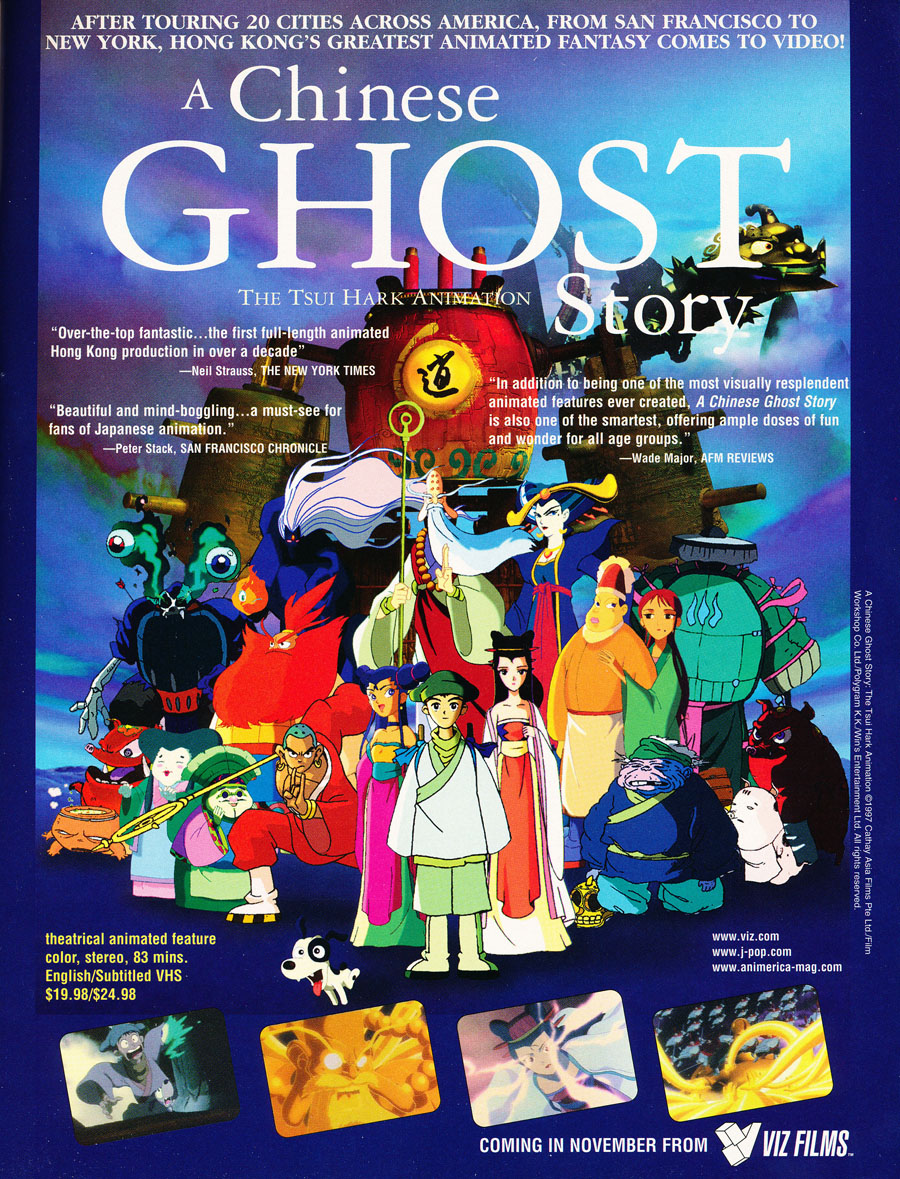 The one and only animated version of the Hong Kong fantasy-romance classic A CHINESE GHOST STORY, scripted, produced and voiced (in part) by the original film’s producer Tsui Hark. Arriving in 1997, a full decade after the enormously successful live action original, this film had a reported four year production period due to its once revolutionary mixture of traditional cell animation and CGI. It wasn’t nearly as successful as its predecessor, and appears pretty dated nowadays, although the animation-CGI hybrid look lends an appropriately hallucinatory tinge to the proceedings, whose raid fire weirdness is paramount to their effectiveness.
The one and only animated version of the Hong Kong fantasy-romance classic A CHINESE GHOST STORY, scripted, produced and voiced (in part) by the original film’s producer Tsui Hark. Arriving in 1997, a full decade after the enormously successful live action original, this film had a reported four year production period due to its once revolutionary mixture of traditional cell animation and CGI. It wasn’t nearly as successful as its predecessor, and appears pretty dated nowadays, although the animation-CGI hybrid look lends an appropriately hallucinatory tinge to the proceedings, whose raid fire weirdness is paramount to their effectiveness.
The protagonist is Ning, a debt collector in Medieval China who upon encountering a ghost beauty named Shine is immediately smitten. Together with his dog Solid Gold he’s led into a world of ghostbusting swordsmen, disembodied eyeballs and a literal ghost town in which human body parts are served as delicacies and staircases walk. There Ning once again meets Shine, whose ghostly sister Butterfly spies the two of them engaged in PDA. Butterfly reveals what she saw to Dragon Lady, an ancient tree who needs to devour souls in order to retain the appearance of a beautiful woman. Ning, it seems, is set to be her next victim.
Ning, Solid Gold and Shine wind up on a floating reincarnation train upon which the souls of the dead are transported to their next incarnation. They manage to escape, with Shine stationing herself at the bottom of a lake in order to avoid the sunlight (which is toxic to ghosts), and then hiding in Ning’s folded-up umbrella.
Ning and Solid Gold take up with a red bearded ghostbuster identified, appropriately, as Red Beard. He’s opposed by the less virtuous White Cloud, who gets into an aerial battle with his foe that nearly destroys Ning. Later they confront Dragon Lady, who ends up reverting back to her initial tree state, after which Ning, Solid Gold and Shine reboard the reincarnation train—this time, it seems, for good. White Cloud, of course, has other ideas.
Some words about A CHINESE GHOST STORY’S parentage: it was, as previously stated, remade from a 1987 Tsui Hark produced, Siu-Tung Ching directed live actioner, which was itself a remake of the 1960 Shaw Brothers production THE PAINTED SHADOW. All three films were loosely adapted from a 17th Century story by Pu Songling called “Nie Xiaoqian” (a.k.a. “The Magic Sword”), found in the collection STRANGE STORIES FROM A CHINESE STUDIO. A CHINESE GHOST STORY also inspired two sequels in 1990 and ‘91, and a live action remake in 2011. The present version is, I believe, the most interesting of the lot, and certainly the wildest, with music numbers and a great deal of bizarre imagery taken directly from Chinese folklore.
The film, in fact, is far closer in spirit to the rapid fire insanity of Tsui Hark’s famously unfettered fantasy epic ZU: WARRIORS FROM THE MAGIC MOUNTAIN (1983) than the comparatively stately and restrained 1987 CHINESE GHOST STORY. The craziness is furthered by the traditional anime visuals (all the characters have very large eyes and mouths) situated amid computerized landscapes of rock, flowing water and waving grass. It all makes for a film that’s consistently watchable and entertaining, even if it rarely ever makes sense.
Vital Statistics
A CHINESE GHOST STORY (XIAO QIAN)
Film Workshop/Polygram
Director: Andrew Chan
Producer: Tsui Hark
Screenplay: Tsui Hark
(Based on a story by Songling Pu)
Editing: Mak Chi Sin, Tsui Hark
Cast: Jan Lamb, Tsui Hark, Anita Yuen, Kenji Utsumi, Bak-Ming Wong, Charlie Yeung
